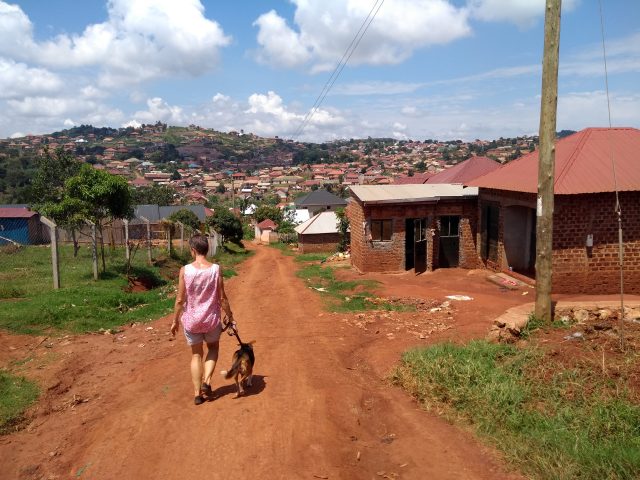When Julie G. was nine years old, she had an adventurous playdate at a friend’s house. Both girls climbed onto a large boulder in the garden, and Julie slipped and tumbled down. She scraped up half her body, but she wasn’t done playing.
Next, her friend suggested they ride their bicycles, which they did until Julie fell off, and added new bumps and bruises. After that, the pair decided they’d be better off playing indoors. The two girls started competing to see who could spin around the fastest and longest. Julie technically won, but she got so dizzy she fell over and earned a black eye.
When Julie’s mother arrived to pick up her daughter, the other mother tried to apologize. Julie was black and blue, and a bloody mess. “She’s fine,” Julie’s mother insisted. “You could draw a line on the ground, and Julie would trip over it.”
At the time, neither Julie nor her mother gave the incident much thought. Scrapes and scratches were the natural marks of childhood. Why should they keep a girl from playing? Julie certainly never thought to cry or make or fuss.
But looking back as an adult, Julie realized the episode was emblematic of her upbringing and her approach to life. “I have a high pain threshold,” she said. “I don’t know if it’s something I learned and internalized, or if that’s just how I was born. You can’t analyze yourself.”
Either way, Julie’s pain tolerance has been extensively tested through nearly two decades of severe and often inexplicable pain. While she’s made some concessions (no driving, for example), she hasn’t let pain stop her from following her interests, wherever they lead.
A Child of Three Countries
Julie’s parents had wide-ranging interests that they followed across the globe. Julie’s mother was a California native who, along with her family, emigrated to England as a teenager. She was working on her degree in psychology when she got married and started a family. Over the course of her career, she worked as an event coordinator, primary school administrator, and the secretary for Cambridge University’s anatomy department.
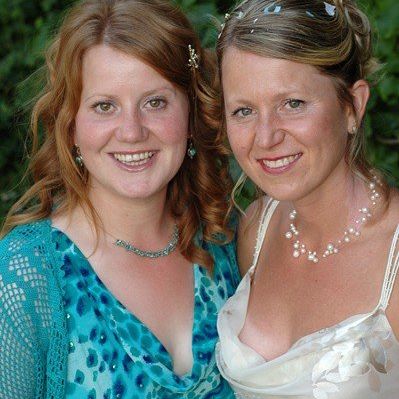
Julie’s father was a well-regarded professor of veterinary medicine, and specialized in the care of horses. When he moved to a new university, he brought his family with him.
From the time Julie was born in 1972, until she was nine years old, her family lived in Fordham, Suffolk, in the UK. Her younger sister, Shelly, was born six years after Julie.
As a young child, Julie was often sick with respiratory infections, and suffered unexplained fits and convulsions. After her first vaccination, she had a major convulsion. Afterwards, her parents were loath to sign her up for additional vaccinations.
In 1981, the family moved to Uppsala, Sweden, where Julie’s father worked on a year-long research project. Although Julie didn’t speak a word of Swedish, she took to her new home immediately. Within three months, Julie was speaking Swedish as well as her classmates, and had a new set of best friends and favorite teachers.
She was devastated when the family moved back to the UK, and even more devastated when, a few months later, her father was offered a job heading a veterinary school on the outskirts of Melbourne in Werribee, Australia. She still considered Sweden her home, and was attached to her friends in the UK. She had a hard time warming up to her new country.
Australia, it turned out, was warm enough. The family arrived at the beginning of a scorching hot summer. The bush fires and dust stores Julie witnessed were frightening, and contrasted sharply with her memories of Sweden.
To make matters worse, her classmates in Melbourne teased her for her clothes, her attitude, and her posh English accent. It took years for her to adjust to her new home and learn to love it. (She still maintains dual citizenship in Australia and the UK.)
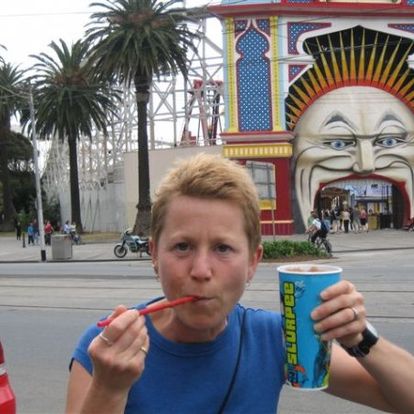
Going Alone
In the tenth grade, Julie’s teacher praised her skill at math, which was enough to convince her parents that they were raising a budding engineer. They couldn’t have been prouder. Julie set aside her interest in drama and arts classes so she could study computer science and social science. In college, she double majored in engineering (electrical and electronic), and science (which included courses in physics, math, and computer science). She graduated in 1995.
After graduation, Julie broke her longstanding vaccine abstinence. She and a friend decided to spend a year backpacking through Africa, and vaccinations were a necessity. In 1996, the two friends flew to Egypt, and worked their way down the continent to South Africa.
In the tradition of college road trips, they didn’t exactly travel in style. They often wedged themselves into their seats for 14-hour bus rides, and crowded into utes (a pickup truck-like vehicle) with chickens, pigs, and sacks of rice.
But Julie had far too much fun making friends with the locals and taking in the sights to complain. She watched the annual wildebeest migration in Kenya, toured the Egyptian pyramids on horseback, and paddled through Botswana’s Okavango Delta in a dugout canoe. When it was time to return to Australia, she brought back an enduring love of Africa, and the people she met there.
Soon after she got back to Australia, Julie got a job with a Swedish telecommunications company. She spent the next seven years bouncing from one engineering role to another. Her work would include extended stays in Sweden and Taiwan.
But no matter where she went, or what roles she assumed, Julie just couldn’t feel passionate about engineering. She was more sociable than most of her colleagues, and she craved authentic human connection. She remembered crouching next to strangers in the back of a ute, and laughing at their funny stories. Even in client-facing roles, she couldn’t replicate that feeling. Her conversations were too formal and scripted, and too full of business jargon and technical topics.
She decided to look for a new career. She came up with a short list of options – firefighter, teacher, nurse, paramedic – but decided to become a teacher because the prerequisites were the most realistic.
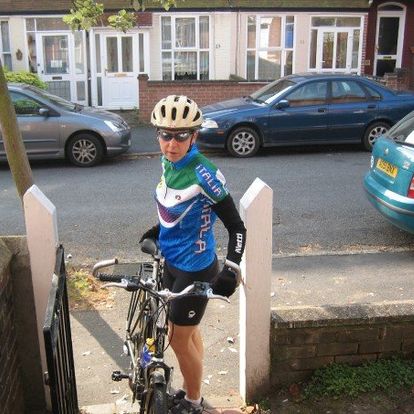
Love and Pain
While she was trying to get her career on track, Julie started to notice a few minor health problems. She was screened for autoimmune diseases, including lupus and scleroderma, and treated for Lyme disease, but none of these tentative diagnoses panned out.
In 1999 she was diagnosed with Raynaud’s disease, a disorder affecting small blood vessels. That would explain why her extremities seemed to shut down at the slightest touch of cold, and why her fingers and toes were covered in chilblains, even though the weather in Australia wasn’t especially frigid. The doctor offered her an angina medication, as well as an ointment, but explained that Julie could manage her condition most effectively by sticking to warm climates.
Julie scrupulously took notes, which she proceeded to disregard. In 2003, she returned to the UK and started a teacher training program in Norwich. During her second placement, she volunteered to lead a group of schoolchildren to the Peak District National Park, between Manchester and Sheffield.
On the long bus ride to the north of England, Julie noticed something was off. Bus seats weren’t always comfortable – she understood that – but these were particularly bad. No matter how she squirmed or shifted her weight, she couldn’t find a comfortable position.
She knew something was wrong, but she didn’t know what. And anyway, she didn’t have time to fixate on her aching posterior. She was chaperoning a bus full of kids on a trip away from home. She had enough to worry about.
And there was something else to distract her. Or someone, rather. There was another teacher on board, a business and economics teacher named Paul. Julie had noticed him before at school. He was tall, good-looking, wore suits, and acted (it seemed to Julie) like the quintessential English gentleman.
On the trip, they started talking, and realized they had a lot in common. They bonded over their love of the outdoors, travel, and mountain climbing. He seemed to like her, and she definitely liked him. The only problem was that he was moving to Bristol, which was more than 200 miles away from Norwich.
The two had a magnetic attraction. They kept up their long-distance (or at least, medium-distance) relationship through the fall, until Julie managed to move to Bristol. They got engaged in June, and married six weeks later, in August of 2005.
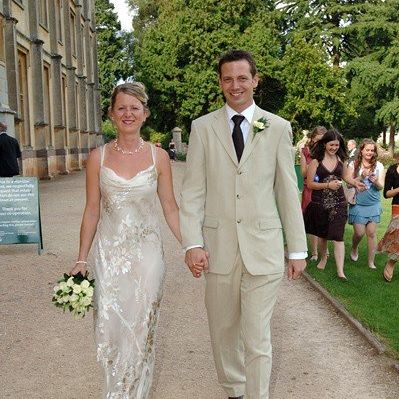
But while Julie’s personal life was in great shape, her body wasn’t doing so well. In Bristol, her knees started to ache, and her hamstrings throbbed. She suspected these pains were the result of too much cycling and running, but she visited a physiotherapist to confirm. The PT diagnosed her with piriformis syndrome, and assigned some therapy exercises. But after six weeks of physiotherapy, she was no better than when she started.
If the PT had other theories, Julie didn’t stick around to hear them. As soon as Paul got his visa, the two of them boarded a plane and headed back to Australia.
Julie’s pain quickly intensified, although she had no idea why. Now everything hurt. She tried to massage the pain away, but it did no good. Getting out of bed in the morning often seemed impossible. In spite of the pain, she managed to keep working. She walked every day. It was tremendously painful, but it helped her feel human. She hoped that eventually, it would help.
In December of 2005, she visited a rheumatologist in Perth who diagnosed her with fibromyalgia. It was nice to have a name for her condition, even though there was nothing the rheumatologist could do to treat it. For the next seven years, her life would be constant, unrelenting pain.
The rheumatologist did advise her to stop the massages, and when Julie took her advice, the pain lessened. Over time, she realized that touch could cause her sensitized nerves to flare. She learned to avoid not only massages, but also foam rolling, TENS devices, and even loofahs. Avoiding these things didn’t eliminate her pain, but it helped to keep the pain from spiraling out of control.
Julie spent years experimenting with other types of therapy. However, she was living in a remote town in Western Australia, and her options were limited. She went to three pain clinics in Melbourne, but they were of no help. She tried different modalities of physiotherapy, and got facet joint injections. She tried different diets and supplements, but nothing seemed to work.
Branching Out in the Tropics
Instead of allowing the pain to control her life, Julie used it as an excuse to develop new interests. Before she got sick, she was physically fit and active, and wanted to be so again. She took it upon herself to study exercise science and exercise therapy. In 2009, she earned her physical trainer/fitness instructor certificate. She figured personal training was a good back-up plan, in case her illness prevented her from keeping a full-time teaching position.
Shortly thereafter, she and Paul decided to further their education by getting a matched set of masters’ degrees. Paul selected European public policy, while Julie went with International Crisis Management. Both of them continued to work part-time as teachers.
She also applied to Australian Volunteers for International Development (AVID), a government-run overseas program. She was selected, and in 2011 she was assigned to work in Manila, Philippines, as the volunteer coordinator of a group dedicated to feeding young children. She also worked with the children’s parents by connecting them with employment training and opportunities, and encouraging them to take an active role in their children’s education.
The tropical climate ranged from very warm to hot. Julie couldn’t be sure, but perhaps that was why her pain ebbed. It didn’t go away entirely, but the all-consuming, all-over pain began to loosen its grip. There were entire days when she was pain-free.
When her Manila posting expired, the couple did a brief stint in Hungary for Paul’s schooling, then both were offered a year-long contract teaching at a school in Khartoum, Sudan. Julie was glad for an excuse to return to Africa, and quickly came to appreciate the kind and generous people she met there. Again, the heat seemed to sooth her pain. But the political situation in Sudan made a long-term stay untenable, so after a year, the couple headed back to Australia.
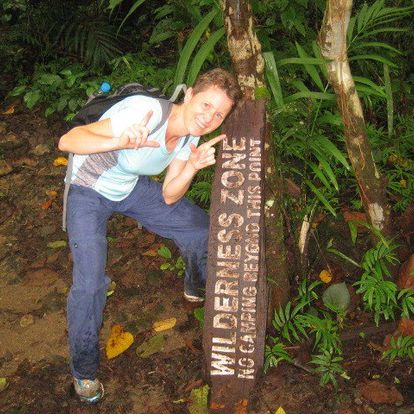
The Limits of Politeness
In 2014, Julie got her second AVID posting in Samoa. She would spend a year developing policy for early childhood education, an assignment which suited her talents and her interests. But Julie also struggled with a unique point of Samoan etiquette.
When an older person was speaking, Julie was expected to sit down. She hadn’t been able to sit comfortably since 2004, but when she tried to explain this quirk, her Samoan colleagues got suspicious. The custom was so ingrained (and Julie’s request was so unusual) that the locals couldn’t interpret her refusal as anything other than rudeness.
Not wanting to alienate her coworkers and neighbors, Julie tried to adhere to this custom. Sometimes she would find herself sitting in meetings for hours at a time. “I couldn’t even think, I was in such screaming pain,” she explained.
She started to notice how often she sat in order to make other people comfortable, even outside of Samoa. She began to reconsider the value she placed on social approval.
When the assignment was over, Julie and Paul headed to the UK, where she got a job as a caseworker helping refugees integrate into British life. The job was rewarding, and the Welsh scenery was astonishingly beautiful, but once again, Julie found her doctor was correct about the climate. Britain was far too cold. Unthawing her frozen digits became something of a pastime.
The couple started searching for international jobs once again, and landed gigs at an international school in Timor-Leste, an island between the Philippines and the north coast of Australia. Julie had visited the country in 2002, two weeks after the Indonesian occupation ended. She saw the devastating effects on the country’s infrastructure firsthand.
The mountainous terrain and remote locations made travel extremely difficult. During her 2002 trip, Julie and the friend she was traveling with would have to ask local families for permission to pitch their tent in the corner of a garden or backyard for the night. They often lived without electricity, internet, or medical care. Finding food and water was a constant challenge.
But she was drawn to the people there, and was eager to go back in 2016.The couple stayed until 2018, when they moved to Uganda to teach in another international school.
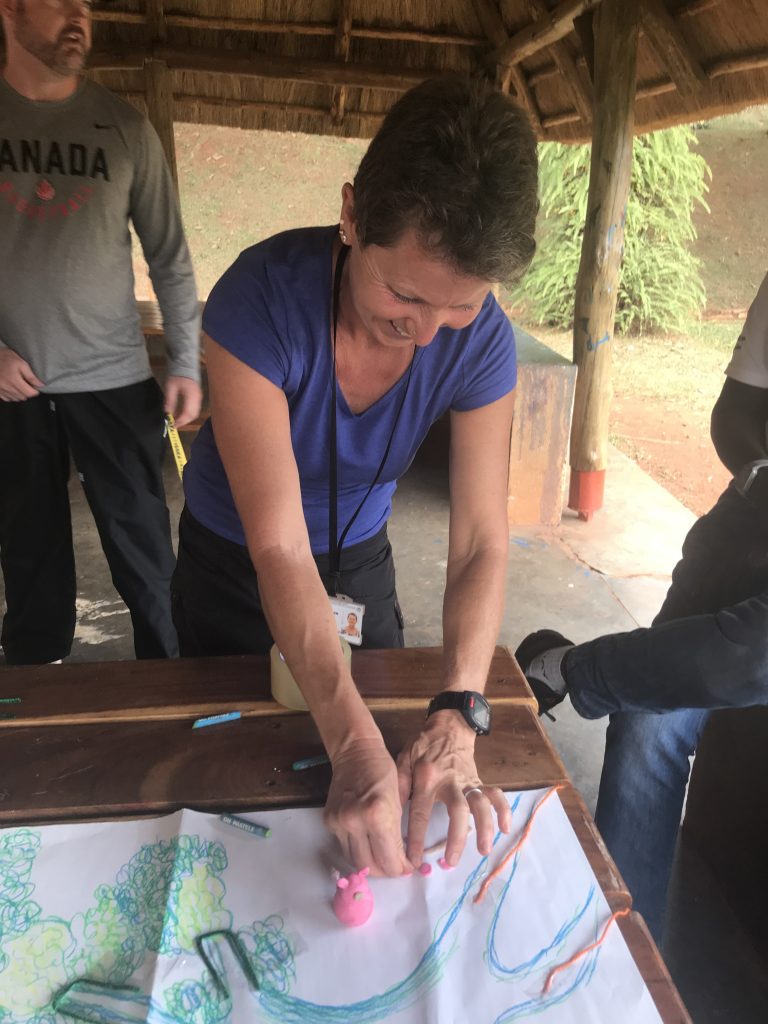
Julie remembered Uganda’s capital city of Kampala from her 1996 pan-Africa trip. She didn’t have a good impression of it then – it was crowded, congested, and had terrible air pollution – but the school she taught in was located in an upscale suburb. Julie was grateful to be kept away from the worst of the city’s problems, but she also felt like she was living in a bubble away from normal Ugandans. She missed being able to participate in normal life.
She also realized that she was getting older, and needed reliable access to medical care. On a trip to Australia a few years prior, she learned how valuable that could be. She visited a doctor and found out she was going through menopause – and had been for the past six years. That explained the night sweats.
And so, she and Paul starting planning a permanent move back to Australia. It has a warm climate, a good national health care system, and a familiar feel.
As of February, 2021, Julie is shifting her career towards social work, a field that aligns with much of her volunteer work. She was recently accepted into a social work master’s program at the University of Melbourne.
Protective Measures
As Julie got older, she started to erect boundaries against pain. She minimized the amount of sitting she had to do. She could stand while teaching, but she started to stand during meetings, dinner parties, restaurant visits, and bus rides. It wasn’t always easy – she felt out of place when her other coworkers were sitting, and she sometimes stood on a bus for over six hours. But even with her stamina, standing got painful after a while.
In 2017, Julie decided to stop sitting down. Pain was inevitable. She was willing to endure it to accomplish some purpose. But being in pain for the sake of observing social niceties seemed silly. So she started eating while standing up, and watching TV while laying down.
“I do find people get offended,” Julie said. “Doctors are about the worst. They want you to sit down, and you say, ‘No thank you.’ And they say, ‘Sit down.’”
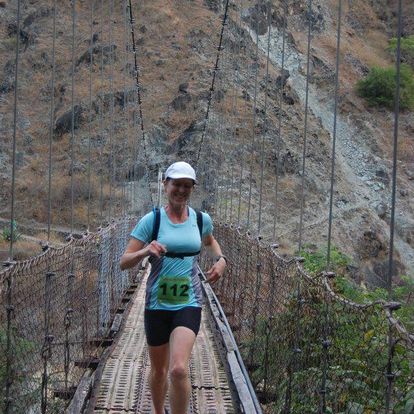
Although her coworkers know about Julie’s sitting pain, they will still reflexively ask her to take a seat. And they will still sometimes assign her to the front table during meetings, where her disability is on full display, and her head blocks other people’s view.
Some of her friends struggle to understand what seems like arbitrary limitations. “They’ll think, ‘How come Julie can do triathlons and go running, but she can’t come to our wedding?’” Julie explained. “To me, it makes perfect sense. But it’s hard when you’re in pain and the other person isn’t. They can’t really wrap their head around it.”
Her husband Paul feels the fallout as well. “He likes restaurants, but not a lot of places have facilities to stand up. We don’t go to the cinema.”
“What I didn’t realize was that most socializing in life happens when you’re sitting down,” Julie said. “People don’t really want to go for a walk with you. They want to sit down. They want to have a meal with you, or have coffee with you. Even students find it hard. They want you to sit next to them.”
Julie readily admits the irony in her inability to sit. “I can run for ten hours on my hamstrings, but I can’t sit on them. I can cycle with them, but if I sit, there’ll be screaming pain. I don’t get it myself.”
A New Pain
Although her fibromyalgia and Raynaud’s syndrome are (mostly) under control, pain is still an ongoing issue. There’s the sitting pain, and then an occasional horrendous pain in her torso, as if someone stuck a blowtorch in her ribcage.
Sleep can be elusive. Because she’s sensitive to cold, her pain worsens at night. And her sensitivity to touch makes her choosy about beds. Once, she and Paul scheduled a three-day trip to the English coast, but they had to leave after the first night, when the mattress caused Julie’s fibromyalgia to flare up.
Her digestive system is also wonky. She’s prone to bloating, heartburn, indigestion, nausea, diarrhea, and pain from her stomach to her bowels. She’s spent years tinkering with her diet, and she’s careful about what she eats. She avoids gluten, dairy, fruit, and excess fats, since these bring on tremendous pain. She tried the keto diet briefly, and regretted it.
Although she’s been aware of her stomach issues since at least 2002, they’ve worsened over the last eighteen months. In 2019, she was diagnosed with a collection of digestive disorders, including severe gastroesophageal reflux disease (GERD), a hiatal hernia, and gastritis.
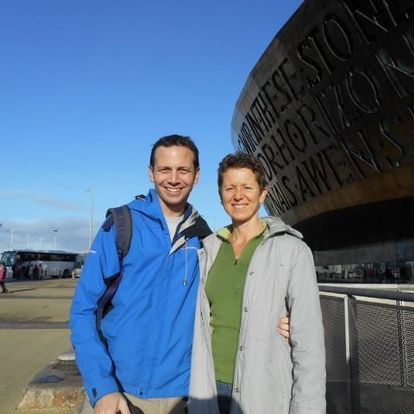
Was it Really That Bad?
Julie’s pain stuck with her through her international postings and career pivots. Although time and climate affected the nature and intensity of the pain, it was a constant and severe struggle. While her fibromyalgia improved in the Philippines, she kept her sitting pain. The digestive issues that plagued her for years got worse.
But even during her worst phases, Julie never let pain derail her completely. She kept pursuing new opportunities and trying new things.
Some of her resilience may be a byproduct of her tough-love upbringing. When Julie first started noticing symptoms of Raynaud’s in the late 1990s, her family encouraged her to downplay the severity.
But Julie also seems to be uniquely well-suited to dealing with pain. She’s a long-time exercise fanatic, and kept up her workouts even when she felt terrible. She started doing triathlons in 2008, and went on to compete in numerous races, both official and unofficial.
Triathlons got her started with running, and soon she was competing in races as well. She started off with relatively modest distances – 10k, then 21k – but graduated to running marathons, and then ultramarathons. In 2011, she ran her first ultramarathon in the Philippines. After running 60 miles, she got to the finish line sweaty, but first. She even beat out the men.
She enjoyed cycling, and ran several long-distance triathlons before switching her focus to running. A few years ago, an Irish lady invited her to do an Insanity exercise tape, and Julie was instantly hooked. She started doing workout videos on her own, and her repertoire quickly expanded to include PRx, the Jillian Michaels oeuvre, and a smattering of videos on YouTube.
Her workouts are a major part of Julie’s treatment plan. Between running and strength training, she works out for about two hours every day.
But Julie also has an amazing capacity to forget unpleasant events as soon as they’re over. “My husband will tell me stories from those seven years,” Julie said, referring to the worst period of her fibromyalgia. “And I’ll be like, ‘Whoa, really? It was that bad?’”
